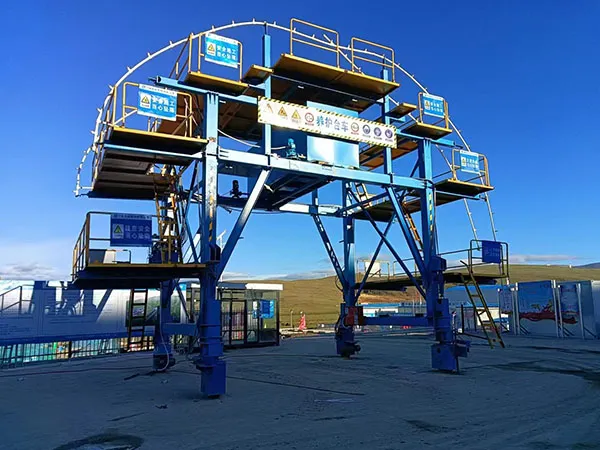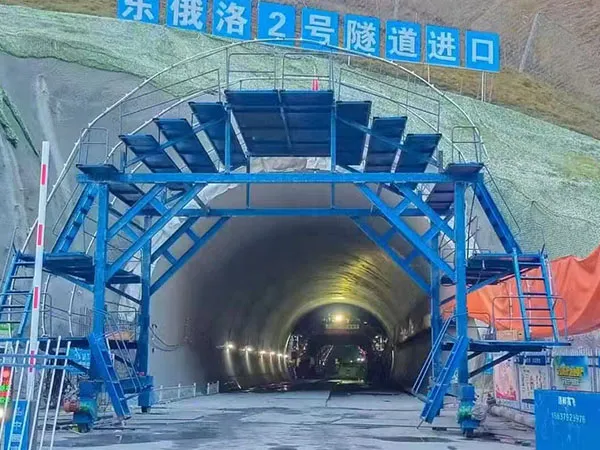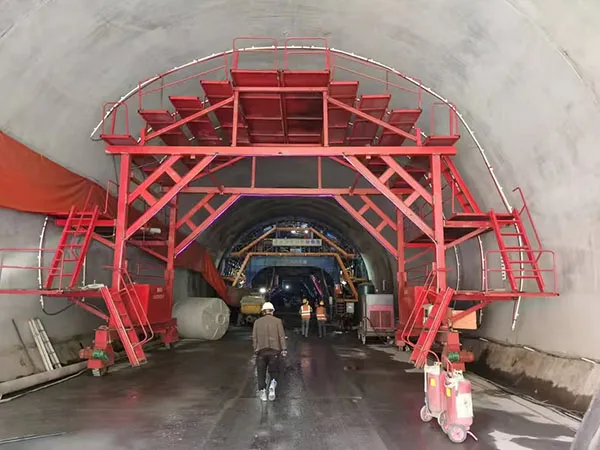A tunnel lining trolley, also known as a tunnel formwork system, is a specialized piece of equipment essential for the secondary concrete lining of a tunnel. The selection of the correct trolley is a critical decision that directly impacts the safety, efficiency, and quality of a tunnel project. The main factors to consider when choosing a tunnel lining trolley are the tunnel's geometry, the construction method, the required production rate, and the level of automation.

A Tunnel Lining Trolley, also known as a formwork gantry or shuttering carriage, is the backbone of the cast-in-situ concrete lining process in tunnels. It is a large, mobile steel structure designed to:
Support the Formwork: It holds the steel molds (forms) in the precise shape of the tunnel's final concrete lining.
Facilitate Concrete Placement: It provides access and infrastructure for pouring concrete into the cavity between the formwork and the excavated rock/soil surface.
Strip and Advance: After the concrete has cured, the trolley hydraulically retracts the formwork (strips it) and moves itself forward to the next section to repeat the process.
Selecting the right trolley is not just a procurement decision; it is a critical engineering choice that directly impacts project speed, quality, safety, and budget. A poorly chosen trolley can lead to construction delays, poor concrete finish, and significant safety hazards.
Tunnel lining trolleys can be broadly classified based on their function, design, and the type of lining they install.
Cast-in-Place (CIP) Trolleys: These trolleys support formwork into which concrete is poured to create a seamless, monolithic tunnel lining.
Telescopic Formwork Trolley: The most common type for long tunnels, the formwork sections retract or "telescope" inwards after the concrete has cured, allowing the entire trolley to pass through the newly cast section and move to the next work area without being dismantled.
Full-Round Formwork Trolley: This type carries formwork for the entire tunnel cross-section (invert, walls, and arch) and allows for a single concrete pour, making it ideal for circular or near-circular tunnels.
Arch Formwork Trolley: This trolley is used when the tunnel invert (floor) is cast separately. It carries the formwork for the upper arch and sidewall sections and is commonly used for horseshoe-shaped tunnels.
Precast Segmental Lining Trolleys: These trolleys are used in tunnels excavated by Tunnel Boring Machines (TBMs). They are designed to transport, lift, and precisely position precast concrete segments to form a complete ring. They often feature erector arms, vacuum lifters, or gripper systems.
Shotcrete Trolleys: These trolleys provide a mobile platform and carry equipment for applying shotcrete (sprayed concrete) to the tunnel walls. They are typically used for temporary or primary support in conventional tunneling methods.

The shape, size, and variations of the tunnel are the primary determinants of the trolley design.
Shape and Size: The trolley's formwork must precisely match the tunnel's cross-section, whether it is circular, horseshoe, rectangular, or another custom shape.
Length and Inclination: The required length of each cast lining segment will influence the trolley's design and capacity. For inclined tunnels, specialized trolleys with hydraulic or four-wheel drive systems are necessary to handle steep slopes.
Curves: For curved tunnels, the trolley must have a transverse shifting or steering mechanism to ensure the formwork stays aligned with the tunnel's centerline.
The overall tunneling and lining method dictates the type of trolley needed.
Cast-in-Place vs. Precast Segments: This is the most fundamental decision. CIP tunnels require formwork trolleys, while TBM-driven projects with precast segments require a segment erector.
Excavation Method: The trolley must be compatible with the tunnel's excavation method (e.g., TBM, drill and blast, or cut-and-cover). The trolley's design must accommodate the space requirements and logistics of other machinery in the tunnel.

The desired speed of lining installation and the overall project scale will influence the level of automation and the trolley's specifications.
Automation Level:
Manual/Simple: Suitable for shorter tunnels or projects with a flexible timeline. These are less expensive but require more labor.
Fully Hydraulic Automatic: These trolleys use hydraulic systems for movement, formwork adjustment, and concrete pouring, offering precise control and higher efficiency.
Smart/Automated: The most advanced systems integrate automatic pouring, vibrating, and monitoring to reduce labor, increase speed, and improve the quality of the lining, but come with a higher initial investment.
Duration and Reuse: For long-term or large-scale projects, the durability, reusability, and low maintenance of the trolley's steel structure become more important for cost-effectiveness.
The specific conditions of the project site can pose unique challenges.
Geology: The surrounding ground conditions and in-situ stress can influence the required strength and rigidity of the trolley and its formwork.
Access and Maneuverability: The trolley must be designed to be moved, assembled, and dismantled efficiently in the confined tunnel environment.
Propulsion: The trolley's movement method should be selected based on the tunnel's layout. Rail-mounted trolleys offer stability but require a rail system, while wheeled trolleys provide greater flexibility on a prepared tunnel floor.
By following this comprehensive guide, you can confidently navigate the complex process of selecting a tunnel lining trolley that is perfectly suited to your project, ensuring a safe, efficient, and successful outcome.
Gaofei
Address: 200m east of tulip garden, group 12 of zhangling community, hongshan street office, hongshan town, xigong district, Luoyang
Tel: +8616638856888
Contact: Gaofei Huang
Mobile: +86-18637923976
Phone: 0379-80881719/ 0379-60162687
QQ: 286827457
E-mail: gaofei@gf-bridge-tunnel.com